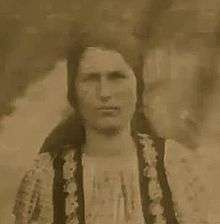Elisabeta Rizea
Elisabeta Rizea (28 June 1912 – 4 October 2003) was a Romanian anti-communist partisan in the Făgăraș Mountains of Northern Wallachia. After the Romanian Revolution, she became the symbol of Romania's anti-communist resistance.[1][2][3]
Elisabeta Rizea | |
|---|---|
 Elisabeta Rizea, circa 1950 | |
| Born | June 28, 1912 |
| Died | October 4, 2003 (aged 91) |
| Known for | Symbol of Romania's anti-communist resistance |
Life
Rizea was born in 1912 in Domnești, a village in Argeș County in the Southern Carpathians, to a family of peasants, Ion and Maria Șuța, who lived off a plot of cultivated land. At age 19 ani she moved to a nearby village, Nucșoara, where she married Gheorghe Rizea, an employee of her uncle, Gheorghe Șuța.[4]
After World War II, the Soviet Army imposed a Communist government in Romania. On the day of the legislative elections of March 1948, Rizea's uncle, a local leader of the National Peasants' Party, was killed by the secret police.[5] This led Rizea and her husband to join an anti-communist guerrilla group, Haiducii Muscelului, led by Colonel Gheorghe Arsenescu. Her assigned task within the group was to provide food and supplies.[4][1] On the night of June 18, 1949, members of Arsenescu's group were ambushed by troops of the Securitate; in the ensuing firefight, two officers were killed, and the group escaped through a security cordon thrown around the area. As a result, a massive search was launched by Securitate troops and two army battalions. She was arrested for aiding the partisan group, beaten, and taken to Pitești Prison, where she was held for 18 months before being put on trial, and sentenced to seven year's imprisonment.[6]
After being released from prison, she continued to provide food and information to the anti-communist fighters in the mountains. When Arsenescu was arrested in 1961, she was again tried, declared "duşman al poporului" (enemy of the people) and sentenced to death because she refused to give information about the other partisans. After appeal, her sentence was set at 25 years, and she was sent to a penitentiary for female political prisoners in Mislea.[1] Three years later, in 1964, she was freed under the terms of a general amnesty.[2]
During the twelve years Rizea spent in prison, she was subjected to various forms of torture: she was hung by her hair from a hook and beaten until she fainted due to broken ribs,[7] and was also scalped, burned, and beaten with a shovel. Upon her release from prison, she had no hair and she couldn't walk, as her knees had been destroyed by the torture.
After the fall of Communism in 1989, her story became known following an interview included in the 1992 documentary Memorialul Durerii by Lucia Hossu-Longin.[3] In May 2001 the former King Michael I of Romania visited Rizea at her home in Nucșoara.[7] During the visit, she told reporters, "When these wretched Communists came to power, they took everything from us, the land, the wooden carts — the hair off our heads. Still, what they could not take was our soul."[2]
Rizea died in 2003 of viral pneumonia, at a hospital in Pitești.[8]
Legacy
In a 2006 poll conducted by Romanian Television to identify the "100 greatest Romanians of all time", she came in 58th. When there was a proposal to build a monument in memory of the anti-communist resistance, Rizea's name was the first on the list, and received the most support from Romanian civic organizations.[3] As of 2019, there are plans to turn her house in Nucșoara into a museum.[9]
References
- Bouleanu, Elisabeth (11 November 2015). "Elisabeta Rizea, simbolul rezistenţei anticomuniste: „Îmi făceam cruce cu limba şi mă rugam la Dumnezeu să mă ajute să nu spun nimic"". Adevărul (in Romanian). Retrieved April 29, 2020.
- "Elisabeta Rizea, 91, a Defiant Romanian". The New York Times. October 10, 2003. Retrieved April 29, 2020.
- Lambru, Steliu (July 29, 2013). "Heroes of the anti-communist resistance: Elisabeta Rizea". Radio Romania International. Retrieved April 29, 2020.
- Moceanu, Răzvan (October 6, 2019). "Portret: Elisabeta Rizea – o icoană a demnităţii, un simbol al rezistenţei anticomuniste" (in Romanian). Radio România Cultural. Retrieved April 29, 2020.
- Hiru, Ion C. (September 19, 2018). "In memoriam: 70 de ani de la asasinarea eroului țărănist Gheorghe Șuța". argesexpres.ro (in Romanian). Retrieved April 29, 2020.
- Deletant, Dennis (2019). Romania under Communism. Paradox and Degeneration. London, New York: Routledge/Taylor & Francis Group. p. 210. ISBN 978-1-138-70742-9. OCLC 1050143513.
- Tănase, Cristina (September 2004). "Elisabeta Rizea, Forgotten Hero Remembered". Vivid Online. Archived from the original on 2005-02-24.
- "Elisabeta Rizea de Nucșoara". România Liberă. 11 October 2003.
- Grigorescu, Denis (May 31, 2019). "Casa Elisabetei Rizea de la Nucșoara va deveni muzeu. Ultima sa dorință: „Trei zile dacă mai trăiesc, dar vreau să știu că s-a limpezit lumea"". Adevărul (in Romanian). Retrieved April 29, 2020.
External links
- (in Romanian) Website dedicated to the memory of Elisabeta Rizea